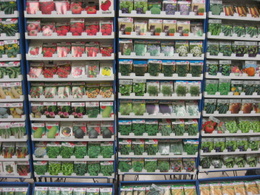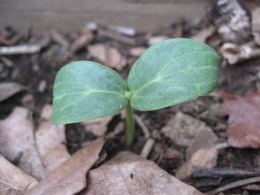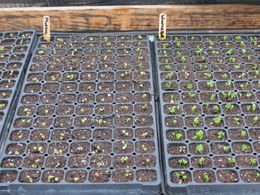Seed Starting
Seed starting can be a very enjoyable part of gardening. You will have a tremendous variety of plants to choose from and you can save a lot of money. Your local garden center may have a half dozen tomato varieties to choose from, while the seed companies will give you hundreds of varieties to choose from. Many of the best heirloom varieties are only available from seed companies. Starting from seed is also a good way to save money. For the cost of 1-plant you could buy hundreds of seeds.
Seeds 101
A cotyledon ("seed leaf" from Greek) is the first thing you see pushing up from the surface of the soil and the seed capsule is often attached at the tips. It is the first leaf or leaves that are developed by the embryo of the seed plant.
In botany there are two types of seeds. The monocotyledon type has a single embryonic seed leaf and the dicotyledon type has two embryonic seed leaves. Anyone that has started growing their tomatoes or cucumbers from seed will recognize that they have two embryonic seed leaves. Dicots are the most common types that gardeners will encounter. Onions and grasses are examples of monocots.
If you were to hear a botanist talking you would most likely hear the shortened terms monocot and dicot.
As the cotyledon grows, the seed capsule will drop off on its own. The plant’s initial energy storehouse is in the cotyledon leaves. Down below in the soil a tap root has already formed. At this stage it is known as a white thread root. From the white thread root the feeder roots will form to provide enough nutrients to grow the plant’s true leaves which look like the mature plant’s leaves.
Seed Starting
Indoor seed starting is usually done with seed starting trays also called by professional growers as propagation trays. The seed starting trays can be found at your local garden center as well as at the large retailers. Common seed starting trays may have 10, 12, 36, 50, 72 or as many as 98-individual cells. Many can be found with the cells already filled with the starting soil-less mix in them. It is important to use a good sterile seed starting mix.
If you plan to start from seed you need to plan ahead to make sure that you have the seed starting tray early enough. The big box stores start getting their large seed displays and seed starting supplies set up in January and February. In the northern states there may be snow on the ground, but that is the ideal time to get your seed starting supplies when there is a large selection.
The Jiffy seed starting pellets are a popular and reliable seed starting method for the beginner. It is a good way to get children interested in gardening.
If you want to start your own tomatoes, a good time to plant the seeds are about 6 to 8-weeks before the last frost date in your area. If you are not sure when that is, your local Cooperative Extension can not only tell you when it is, but also can give you a lot of other helpful advice. It is not a good idea to start your seeds too early because the plants will be very tall and spindly and root bound long before the last frost date.
Most seed starting mixes are peat based and are dry when you buy them. When planting seeds, the seed starting mix needs to be moist, before planting your seeds. The fastest way is to use warm water around 100 to 105-degrees F. At this temperature the peat starting mix will absorb the water faster than cold water, which will often just sit on top without being absorbed.
A container of water sitting on a sunny windowsill will usually be at the right temperature.
Do not plant the seeds too deep; a light covering is all that is needed. The seeds need to be warm and kept moist for them to germinate. Watering with lukewarm water, not warmer than 105-degrees F, will help speed up the process. Use a very small gentle stream of water to avoid disturbing the seeds. In many cases bottom watering works very well.
Many seed starting kits have a clear plastic cover to make a mini-greenhouse. This will keep the seeds moist and warm and will speed up the germination process. Do not place in direct sunlight because the temperature will be too high. Once the seeds have emerged remove the cover so that the sun does not overheat the seedlings.
Not all seeds are the same genetically. Each has a slightly different genetic makeup and will have some slightly different characteristic just as we do. It is always a good practice to plant 3-seeds and keep the strongest one.
When your seedlings are well rooted, remove the plants from the starting tray and replant them in a larger pot or directly into your garden when it is warm enough.
Dampening Off
Dampening off is one of the most common problems when starting from seed. The seedling emerges and appears healthy, but then shortly it wilts and dies. Dampening off is caused by a fungus that occurs when the soil is too wet, usually before the true leaves have emerged and a strong root system has developed. Dampening off only affects the young seedlings. Once they get past the seedling stage and the true leaves appear they will not be affected by the fungus.
To help prevent dampening off use a sterile seed starting mix and keep the soil damp, not wet. If you reuse seed starting trays and pots they should be sterilized by soaking them in a solution of 1-part bleach to 10-parts water for 30-minutes.
Heat and Light
Gentle bottom heat from a seed starting heat mat is also helpful especially if your seed starting room is cool. Some seeds will germinate at cooler temperatures, but most will require temperatures of 65 to 80-degrees to germinate. You will achieve the best success in seed starting in a warm area with direct sunlight, which will provide the light and warmth needed for germination. If you are using a seed starting heat mat, check the soil more often since the soil will dry out sooner. Heat mats are seldom found in garden centers, but Gardener’s Supply Company has several sizes.
Once the seeds have germinated, the seedlings need sunlight or another bright light source, such as a grow light placed 4 to 12-inches above the plant tops. Light from incandescent bulbs do not work very well because they put out too much heat. A good quality grow light will give your seedlings the light they need.
When to Repot
Plants have different tolerance to light frost and cold soil conditions. In general about 2-weeks before your last expected frost you can repot your seedling into a 3 to 4-inch pot using your good garden soil. You can use a teaspoon to gently lift the seedling out of your seed starting tray to repot it into larger pot.
A cold frame is the best way to harden off and get your seedlings established with a healthy root system. During the warm days you should open or prop up the cover so that your plants do not get burned from the hot sun. Be sure to close the cover at night when it gets cold to protect them from frost.
If you do not have a cold frame, then place your seedlings in a shady location that is protected from the wind for several days. Gradually expose the plants to increasing amounts of sunlight until they are in full sun. You should bring your seedlings inside at night when it gets cold. Fencing should also be used if deer or other animals are a problem.
When to Plant
Some of the cool weather plants can be planted in your garden a week or two before your last expected frost. Warm weather plants such as tomatoes , squash and zucchini need the soil temperatures to warm up and will do best if you wait a week or two after the last expected frost date.
Seeds to Start Indoors
Plant broccoli, Brussels sprouts, cauliflower, eggplant, parsley, pepper and tomato 6 to 8-weeks before the last frost date in your area.
Seeds to Plant Early
Plant beet, broccoli, Brussels sprouts, cauliflower, carrot, lettuce, onion, pea, radish and spinach 2 to 3-weeks before the last frost date in your area. Check the seed package for specific planting instructions for the variety you are planting.
Seeds to Plant after Last Frost
Plant cantaloupe, cucumber, garden beans, pumpkin, squash, sweet corn, Swiss chard, watermelon and zucchini 1 to 2-weeks after the last frost in your area. These seeds germinate best when the soil has warmed up.
Garden Spikes newsletters give you timely information once or twice a month. Subscribe Free to the Garden Times newsletter below.
Your email address will only be used to send you a newsletter and will never be sold. You can unsubscribe at any time.



